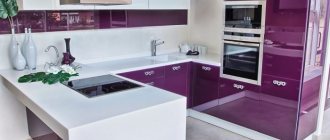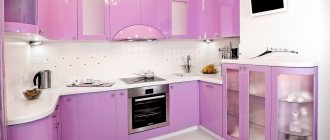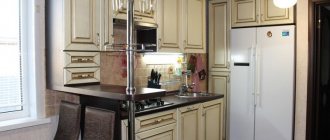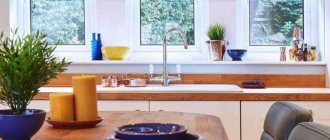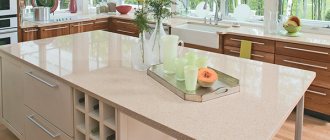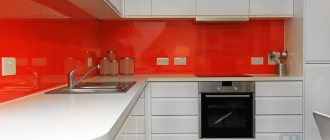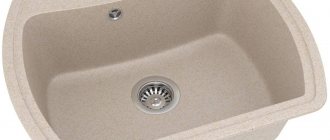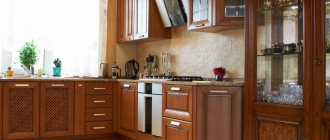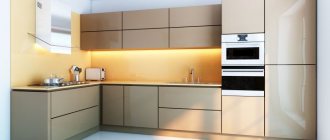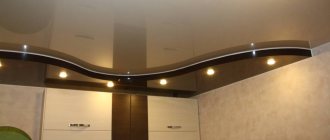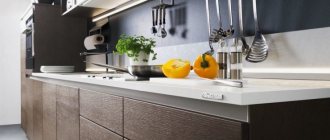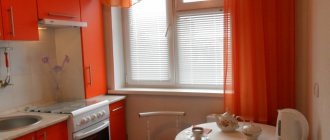The variety of choices for kitchen facades can sometimes lead the consumer into a dead end. Especially if different materials have an external similarity and differ little in price. If you are wondering what to choose: a kitchen with an enamel coating, acrylic or plastic, this article will help you decide. The Biograph Kitchens factory produces kitchen furniture with any of the listed types of facades. Book a consultation with a specialist on our website - we will answer all your questions.
- Kitchen "Orlando"
- Kitchen "Stella"
- Kitchen "Venice"
What are acrylic facades?
At first glance it may seem that the panels are made of plastic. This is wrong. Thin MFD or chipboard panels are covered with special sheets of polymethacrylate, more often called acrylic.
MDF panels coated with acrylic.
This helps to ensure not only strength, which is important for furniture facades, but also wide design possibilities, as well as a characteristic glossy shine. MDF with acrylic coating is absolutely harmless, does not emit toxins when heated, and with proper care will last for many years.
High-gloss acrylic panels are easy to clean and do not fade over time. In addition, the properties of acryline help it not to absorb dirt and grease.
Acrylic kitchens: getting to know each other in absentia
Are you planning to buy for yourself or sell stylish headsets to clients that look expensive and impeccable? Then high-gloss or deep matte acrylic facades are beyond competition!
Polymethylacrylate with a thickness of 1 mm outperforms plastic and film in this parameter. Outwardly, it looks like enamel, but the original color remains for many years.
- A non-fading “mirror” expands the kitchen space and gives airiness.
- ECO material does not contain volatile compounds, harmful resins and impurities.
- You will not find cloudy reflections, shagreen, thick glue lines or waviness.
Manufacturing technology of acrylic facades for kitchens
There are two ways to manufacture such facades: one-sided and two-sided. In the first case, the acrylic sheet is glued only to the outer part, leaving the inner part untreated. In the second, both sides of MDF or chipboard are glued, providing the doors with the same appearance from the inside and outside.
The coating is glued using a special glue (for example, Cosmofen or Akrifix), and then placed under a press. In this case, the sections are covered with a waterproof acrylic edge, which prevents peeling of the decorative layer. The thickness of such a facade often does not exceed 16-18 millimeters.
A more expensive option is solid acrylic panels up to four millimeters thick, edged with aluminum. Metal adds strength to them, comparable to chipboard, but they are much more difficult to maintain and are quite expensive.
Plastic headsets: what to consider when choosing
The basis of the plastic facade is the same MDF and chipboard, glued under a press with roll or sheet PVC film. Typically, standard wood-imitation cabinets are made from such panels, but a wide variety of textures and shades are possible. The joints and sections of such facades are treated with polymer and aluminum edges.
When choosing such a kitchen, you should consider the following points:
- Manufacturing plastic products is cheaper than analogues.
- It washes well, there are no visible water stains or streaks on it.
- PVC film can be used to cover milled surfaces.
Pros and cons of kitchens with acrylic facades
In addition to appearance and ease of installation, such facades have a number of advantages:
- Wear resistance. The strength of acrylic reliably protects it from damage due to impacts and scratches. In addition, damaged acrylic panels can be reconstructed to their original appearance. With proper care, they will last up to 20 years.
- Acrylic does not react to temperature changes and is resistant to heating up to 160 degrees. It does not deform when exposed to water, and does not fade from sunlight.
- Grease, soot and dust are not absorbed into the surface ; it can be easily cleaned with a simple detergent and a soft cloth. We recommend: Once every three to four months, treat facades with sprays that help maintain a glossy shine, for example, Weiss or Cosmofen.
- Large selection of design solutions. Acrylic panels are presented in a wide palette. In addition, you can decorate them with prints or airbrushing or decoupage.
- The glossy structure due to its reflective properties makes the room lighter and more spacious .
- Acrylic panels, unlike plastic ones, do not release toxic impurities into the air when heated. Therefore, acrylic can be considered an environmentally friendly material.
However, it was not without its drawbacks:
- Due to the manufacturing technology, acrylic facades are quite expensive . The cost of a solid acrylic facade can reach $600 per linear meter, and an acrylic coating can cost $100. At the same time, taking into account the quality, the price can be considered relatively affordable: the long service life fully pays for the costs of manufacturing and installation.
- The glossy surface is very difficult to handle. It does not scratch or chip, but any fingerprints and dust become much more noticeable. You will have to regularly wipe away streaks and stains. Please note: Special grease-repellent polishes will help prevent the problem.
- High shine. The disadvantage is conditional, but over time many people begin to be annoyed by the glossy mirror structure of the acrylic facade.
Differences between acrylic and plastic coating
Acrylic is a denser and more durable material; high-pressure coating technology with heat treatment completely seals the joints of chipboard and PVC, preventing the penetration of moisture. When using plastic, the edges of the products are treated with an additional edge, which, when in contact with water and high temperatures, tends to peel off and contribute to deformation of the base material. In addition, there is a high probability of accumulation of grease and dirt between the panel and the edge, which are very difficult to remove without damaging the furniture.
Acrylic surfaces are not susceptible to physical impact and always retain color fastness. When using low-quality plastic film, chips, damage to the coating, and dents are possible. In addition, plastic surfaces can fade and lose brightness over time.
It is worth noting that acrylic material is safe; it does not contain impurities or resins, and is also recyclable without harming the environment.
What is better to choose for kitchen facades: acrylic or plastic?
As mentioned above, acrylic is much more environmentally friendly than plastic. But is this the only difference? We offer a comparative table of the two materials.
| Acrylic facades. | Plastic facades. | |
| Gloss. | Clearly expressed, with a mirror shine. | Compared to acrylic, plastic is duller. There are matte options. |
| Temperature resistance. | It tolerates heating up to 160 degrees without releasing toxic impurities. | Good HPL or CPL plastic can withstand temperatures up to 140 degrees, but cheap options begin to release toxins at 80 degrees, so they should not be placed near the stove. |
| Term of use. | With proper use - up to 20 years. | After just a couple of years, it may begin to fade from heat and direct sunlight. |
| Price. | High-quality acrylic will cost you quite a lot. | Affordable price. |
| Facade type. | Only deaf. | Deaf and radius. |
Let's summarize: Acrylic facades are more durable and reliable, but the price is not encouraging. At the same time, plastic facades are more affordable, but they are more capricious in everyday use and they cannot be placed next to heat sources.
Difference in selection criteria
Which of the two kitchen facade options is better to choose - enamel or plastic? Only the buyer himself can have a definite answer. He will have to decide what is more important to him: the fading resistance of enamel or the scratch resistance of plastic. Or maybe the heat resistance indicator matters: plastic has less, but a kitchen with an enamel coating can be installed near a gas or electric stove.
In terms of the choice of colors, and, consequently, design, kitchens with enamel facades are in a more advantageous position. The variety of stylish solutions is also somewhat greater in these sets than in kitchen collections with plastic coating. In terms of budget availability, both options are identical and quite affordable to purchase.
What color should acrylic facades be made in?
The design palette for acrylic facades is extremely wide. Many colors and shades, the possibility of decorative design. We invite you to look at the most popular options among designers - perhaps you will find your ideal kitchen.
A white acrylic kitchen is a great choice for small spaces. Due to the color and glossy texture, it reflects light, visually enlarging the room and making it lighter and more spacious. However, keep in mind that such facades are very difficult to maintain - all the dirt and drops of grease are visible on the white surface, so you will have to wash the set often.
An interesting solution is a black and white acrylic kitchen . The classic combination looks very catchy thanks to the mirror shine. However, it is important to maintain a balance here: it is better if the colors are combined with each other, and do not overwhelm each other.
If such a combination seems boring to you, dilute it with another shade - it is better to choose bright colors, for example, pink, light green, blue.
Bright red is on trend right now, but we recommend being careful with it. Aggressive tones quickly tire the eyes, so monochromatic design in this case is not the best choice. Dilute it with calmer, pastel shades - beige, gray, golden.
The same applies to yellow kitchens. However, it all depends on the chosen tone. Soft colors will make the kitchen fresh and brighter, but bright colors require a muted edging.
A monochrome black kitchen is a bold but very stylish solution. It is important to pay attention to details: any inappropriate accessory, the slightest contamination - and the impression is ruined.
Comparison of composition and technical characteristics
Acrylic paint contains:
- pigments and fillers needed to determine paint color
- functional additives.
- monomers of acrylic copolymers, this is the base of the paint
- auxiliary monomers that affect the properties of the paint
Functional additives include emulsifiers that affect the surface coating, organic solvents affect the strength of the connection, and stabilizers prevent component particles from settling.
The enamel contains the following components:
- solvents
- pigments for color determination
- additives to determine various functions
- varnish
- fillers
The main differences between the compositions of enamel and acrylic are that the enamels seem to be fused to the surface and delight with their durability, but have a pungent odor. Acrylic, in turn, is characterized by quick drying of the painted area and protects it from damage.
Comparison of consumption per 1 m2
The consumption of enamel or acrylic depends on the surface itself. If the surface is rough, you will have to apply several layers to achieve the desired effect. If the surface to be painted is prepared for paint according to all standards and has a glossy surface, then for acrylic paint 1 - 2 layers and 0.2-0.25 liters per square meter are sufficient. If you cover the surface of the product with it, then when covering in 2 layers you need 100 - 180 grams.
Important! To find out how much acrylic or enamel you need for painting, you need to calculate the perimeter of the product to be painted and take into account the number of coated layers, usually up to 2.
Manufacturers of acrylic kitchen facades
Acrylic panels are produced by dozens of manufacturers with very different pricing policies.
We offer you the TOP 3 manufacturers popular in Russia:
- Bel Viso using NIEMANN panels. Polish acrylic facades are one of the most famous. A wide selection of decorative designs, a huge color palette and high quality. The price, however, is appropriate - from $150 per linear meter.
- The Sidak company , located in the Leningrad region, will also not please you with the price tag - from $140 per meter. However, the factory goes through the full production cycle: from the panel to the finished facade, which affects the quality.
- Fordom is a more budget option. Turkish facades will cost you an average of $90 per meter. Of course, you can also find cheap acrylic facades. But be careful - most often the tempting price tag hides a low-quality coating or simple plastic, sometimes not even heat-resistant.
Film MDF
During the production process of the material, a polyvinyl chloride film is applied to the MDF board, which performs two functions - protective and decorative.
After treatment with film, the surface of the fiberboard is protected from the effects of a damp environment and deformation, and is easy to clean.
Using PVC film allows you to give the MDF board a glossy or matte surface, imitate it as one of the natural materials (granite, wood, marble), or apply a pattern or design. The advantages of such facades are the following factors:
- affordability;
- wide color palette;
- variety of textures;
- moisture resistance;
- good wear resistance;
- ability to withstand mechanical stress;
- resistance to temperature changes;
- trouble-free removal of various types of contaminants using modern detergents and cleaning products.
Reviews from real owners of acrylic kitchens
If you look at the reviews of people who bought acrylic facades for their kitchen, you will notice one common point - everyone admires their beauty and durability, but emphasizes the capriciousness of their care. Most often, this means the need for regular cleaning.
However, some people think that wiping the facade once a month is enough, but the only disadvantage is the cost.
And some people don’t like the need to use special care products.
Sometimes a change in shade depending on the lighting is noted. Therefore, be careful with pastel colors - in the twilight they may appear dull.
However, the reviews are unanimous on one thing - acrylic facades are reliable, durable and beautiful.
How to care for acrylic facades
As can be seen from the reviews, the main problem with acrylic facades is their maintenance. How to properly care for the panels?
Now we'll tell you:
- Do not use aggressive abrasive detergents.
- When choosing what to wash the panel with, stick to the mildest possible detergents - for example, regular dishwashing detergent.
- Use lint-free soft cloths.
- Wipe the surface regularly to prevent fingerprints and dirt from accumulating on it.
- Use polish for acrylic kitchen facades - it will make cleaning much easier.
Let's summarize: With proper care, an acrylic facade is an excellent choice for kitchen design. A beautiful, eco-friendly and durable set will become a real decoration of the room. Among the disadvantages, we note the high price - however, taking into account the durability of such furniture, it is completely justified.
Features of enamel coating
Enamel kitchen facades are made by applying a multi-layer coating consisting of varnish and dye. Before treating the kitchen structure with this composition, it is primed with a special solution. This gives greater durability to paint components and increases adhesion to wood.
In this case, by selecting different types of paint, it is possible to achieve one of two types of coating:
- matte enamel layer;
- glossy kitchen surface.
One of the advantages in terms of aesthetics of using enamel is the incredibly huge selection of shades. This allows you to formulate a concept for the furnishing style and change the contrast of the interior design. Other benefits of enamel coating include:
- environmental friendliness of the material and the entire furniture collection;
- ease of care;
- resistance to moisture agents;
- variability of texture.
Another advantage is the possibility of using enamel in kitchen designs of complex configurations, with radial shapes, and with a block structure.
